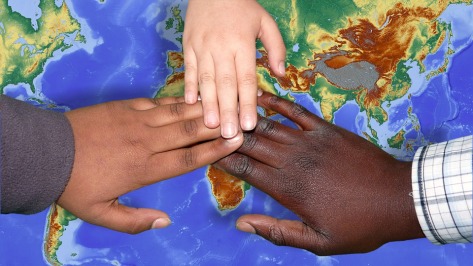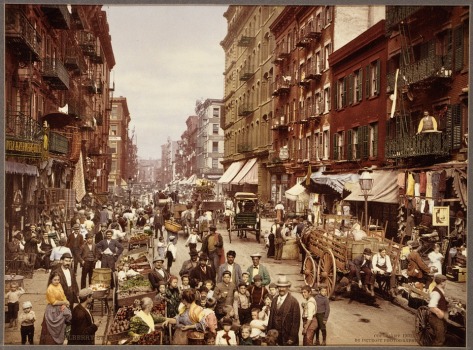Mark Chappell

https://pixabay.com/en/migration-integration-migrants-3129340/
New immigrants coming into the US have faced persecution throughout our countries history. The United States of America has been known as the land of opportunity since its conception. Because of this reputation it has attracted many immigrants from many different countries. Very often these immigrants become victims of racial prejudices. Using the lens of Cultural Studies it is made obvious that as an influx of immigrants of a specific group come to the US they are often faced with hatred from other groups. Cultural studies is defined as, “an innovative interdisciplinary field of research and teaching that investigates the ways in which “culture” creates and transforms individual experiences, everyday life, social relations and power.” (culturalstudies.web.unc.edu). This hatred begins often times because these immigrants are seen as competition in the job market. Many immigrants coming to the US are fleeing from hardships in their homeland. This is usually due to reasons such as war and extreme poverty. In these extreme cases we see many immigrants from a specific area entering the country at one time. The people who already call the US their home often feel threatened by these new groups.

https://pixabay.com/en/statue-of-liberty-landmark-liberty-1210001/
We can see examples of this prejudice throughout our countries history. One early example of racism towards immigrants was directed towards the Irish in the mid-19th century. Irish men and women came into this country fleeing extreme poverty and famine. They came to the US seeking a better life. Because most Irish immigrants were extremely poor, they were deemed as lower class. They often took demanding, and sometimes dangerous jobs in order to make ends meet. According to Takaki, “The Irish became disposable workers. The pervasive presence of the Irish in railroad work produces the popular saying that there was ‘an Irishman buried under every tie.’” (p. 138). This tells us that the Irish in this time were not treated as people, and had no agency. Agency is when an individual is recognized as a person, and treated as such. The Irish women would often take jobs in the service industry. Due to the low entry level of the jobs there was great competition. Irish were often in a race to get the jobs before immigrants of other countries would take them. Immigrants from China would many times be seeking the same jobs as the Irish, this created racism towards Chinese peoples. Takaki tells of one such instance, “Dennis Kearney led an anti-Chinese labor movement, charging that the Chinese threatened the employment of Irish women.” (p. 147). This shows that hatred often perpetuates itself. After the initial reasons for the hatred is forgotten, the hate itself will often remain.

https://pixabay.com/en/welder-workers-safety-glasses-406381/
Our community partner was OneAmerica which fights for immigrant’s rights here in the US. We interviewed a representative of their organization named Pavan Vingipuram that informed us they have bi-monthly meetings in which they discuss ways of increasing the Power of immigrant communities. Power is a group’s access to resources which can influence and control others. One America actively works to create bonds between immigrants in the US. According to their website,
OneAmerica was formed directly after September 11, 2001 in response to the hate crimes and discrimination targeting Arabs, Muslims and South Asians. Called Hate Free Zone at the time, the organization expanded to organize and advocate with many diverse communities of color. OneAmerica has now grown into a leading force for immigrant, civil and human rights. (par. 4)
When we asked how OneAmerica uses cultural studies to change issues facing immigrants Pavan informed us that almost all the people in his organization are immigrants or children of immigrants, so they have dealt with these cultural issues first hand. After the 9-11 attacks immigrants from the middle-east dealt with an increase in hate crimes directed towards them. This was due to the attackers being members of a radical group from the middle-east. This radical group was a very small percentage of people from that part of world, but because of their actions almost all middle-eastern people deal with prejudice. A lot of this incorrect association is due the way these people are portrayed in American media. Often racism and bigotry is normalized by the way it is regularly presented in the media. People may choose to believe what the media tells them, rather than talk to and get to know the people they now share a country with. As Postman states, “The telegraph may have made the country into ‘one neighborhood,’ but it was a peculiar one, populated by strangers who knew nothing but the most superficial facts about each other.” (p. 67) Maybe if the racists among us would go out and talk to these people they hate, they might learn they have a lot in common with them.

https://pixabay.com/en/new-york-city-1890-vintage-559753/
Every one of us aside from Native Americans have ancestors from other countries, which makes us all related to immigrants. Our ancestors left their home countries to seek a better life, one free from persecution. I believe that peoples coming into our country these days seek the same things. We should be open to letting these people of other cultures join forces with us. I think people often take the stance that it is us against them, when we should be combining our efforts in an attempt to make things greater for everyone. I think we all have abilities and talents to give to the world, and when we combine ours with our brothers and sisters from other lands we could make a country worth being proud of. Who knows, in the next hundred years our relatives may be free of racism and bigotry, but it will not be without great effort from the ones who came before them.
References
What is Cultural Studies? (n.d.). Retrieved February 11, 2018, from http://culturalstudies.web.unc.edu/resources-2/what-is-cultural-studies/
Postman, Neil. Amusing ourselves to death: public discourse in the age of showbusiness. Methuen, 2007.
Sutherland Serena, and Pavan Vangipuram. “Interview transcript.” 11 Feb. 2018.
Takaki, Ronald. A Different Mirror: A History of Multicultural America. Little, Brown and Company, 1993.
“OneAmerica.” Home Page | OneAmerica, weareoneamerica.org/. Accessed 11, Feb. 2018
